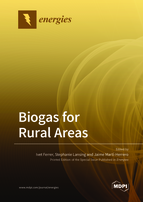Biogas for Rural Areas
A special issue of Energies (ISSN 1996-1073). This special issue belongs to the section "A4: Bio-Energy".
Deadline for manuscript submissions: closed (31 January 2020) | Viewed by 49367
Special Issue Editors
Interests: biodegradable waste; microalgae, sewage sludge, biogas; anaerobic digestion; co-digestion; biomass pretreatment; life cycle assessment (LCA); low-tech digesters
Special Issues, Collections and Topics in MDPI journals
Interests: biogas; anaerobic digestion; life cycle assessment (LCA); wastewater treatment; manure; food waste; low-cost; algae
Special Issue Information
Dear Colleagues,
Bioenergy is renewable energy obtained from biomass—any organic material that has stored sunlight in the form of chemical energy. Biogas is among the biofuels that can be obtained from biomass resources, including biodegradable wastes like manure, sewage sludge, the organic fraction of municipal solid wastes, slaughterhouse waste, crop residues, and more recently lignocellulosic biomass and algae. Within the framework of the circular economy, biogas production from biodegradable waste is particularly interesting, as it helps to save resources while reducing environmental pollution. Besides, lignocellulosic biomass and algae do not compete for arable land with food crops (in contrast with energy crops). Hence, they constitute a novel source of biomass for bioenergy.
Biogas plants may involve both high-tech and low-tech digesters, ranging from industrial-scale plants to small-scale farms and even households. They pose an alternative for decentralized bioenergy production in rural areas. Indeed, the biogas produced can be used in heaters, engines, combined heat and power units, and even cookstoves at the household level. Notwithstanding, digesters are considered to be a sustainable technology that can improve the living conditions of farmers by covering energy needs and boosting nutrient recycling. Thanks to their technical, socio-economic, and environmental benefits, rural biogas plants have been spreading around the world since the 1970s, with a large focus on farm-based systems and households. There are several opportunities to introduce rural biogas plants in small and medium populations using wastewater, agriculture wastes, and organic municipal solid wastes. However, several challenges still need to be overcome in order to improve the technology, financial viability, and dissemination.
This Special Issue aims to gather research papers on recent developments for bioenergy supply in rural areas. Papers describing new insights on bioenergy production and utilization processes; the development of new efficient technologies for biogas production and utilization; full-scale case studies; and environmental, energy, or economic assessments of decentralized biogas plants are particularly expected. Review articles are also welcome.
Dr. Ivet Ferrer
Dr. Stephanie Lansing
Dr. Jaime Martí-Herrero
Guest Editors
Manuscript Submission Information
Manuscripts should be submitted online at www.mdpi.com by registering and logging in to this website. Once you are registered, click here to go to the submission form. Manuscripts can be submitted until the deadline. All submissions that pass pre-check are peer-reviewed. Accepted papers will be published continuously in the journal (as soon as accepted) and will be listed together on the special issue website. Research articles, review articles as well as short communications are invited. For planned papers, a title and short abstract (about 100 words) can be sent to the Editorial Office for announcement on this website.
Submitted manuscripts should not have been published previously, nor be under consideration for publication elsewhere (except conference proceedings papers). All manuscripts are thoroughly refereed through a single-blind peer-review process. A guide for authors and other relevant information for submission of manuscripts is available on the Instructions for Authors page. Energies is an international peer-reviewed open access semimonthly journal published by MDPI.
Please visit the Instructions for Authors page before submitting a manuscript. The Article Processing Charge (APC) for publication in this open access journal is 2600 CHF (Swiss Francs). Submitted papers should be well formatted and use good English. Authors may use MDPI's English editing service prior to publication or during author revisions.
Keywords
- medium- and small-scale biogas plants
- household digesters
- biogas and circular economy
- biogas and decentralized waste treatment
- decentralized bioenergy systems
- life cycle assessment
- environmental assessment
- energy assessment
- economic evaluation
- digestate as fertilizer







